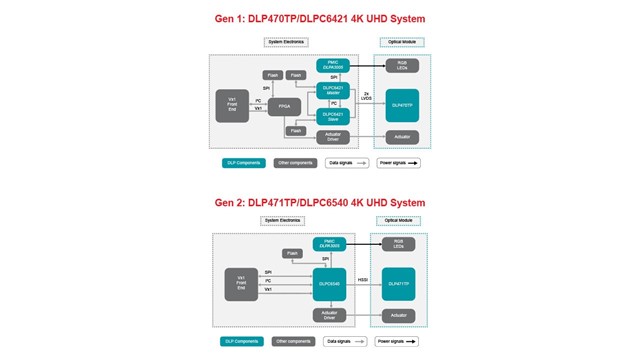SSZT184A December 2023 – June 2024 DLP470NE , DLP470TE , DLP471NE , DLP471TE , DLP471TP , DLP472NE , DLP472TE , DLP650NE , DLP650TE , DLP651NE , DLP660TE , DLP780NE , DLP780TE , DLP781NE , DLP781TE , DLPA3005 , DLPC6540 , DLPC7540
When TI DLP® Technology released its first 4K ultra-high definition (UHD) chipset, content providers and streaming devices were just beginning to offer 4K UHD options. The introduction of the first 0.47-inch 4K UHD digital micromirror device (DMD) enabled designers to develop portable ultra-high definition mobile smart TVs and laser TVs.
Now, that 4K content is everywhere, the next generations of 4K UHD display chipsets from DLP products continues to drive innovation by enabling portable, affordable and easier to use mobile smart TVs and laser TVs.
How Advanced Image Processing Simplifies Setups
Mobile smart TVs and laser TVs with ultra-short-throw (UST) optics are extremely convenient because they can project over 80-inches images from a relative short distance and with a footprint much smaller than traditional flat panel displays. These UST systems prevent consumers from having to mount the projector on a ceiling or place it far away from the screen and instead place it on a surface close to where they will display the image. However, UST optics also make images more sensitive to the positioning of the projector and the flatness of the surface. Additionally, many UST projectors are sold with a screen, requiring a precise setup.
In order to address these challenges, autocorrection features such as auto screen fit and auto warping are integrated in 1080p and 4K UHD chipsets. This makes it possible to leverage a low-cost camera to quickly sense the edges, and then have software correct the image to fit the screen size (see Figure 1). This simplifies setup because consumers can spend less time on precise installations. Even without UST optics, auto correction functions can be very useful if the projector moves or if the surface is not perfectly flat.
The image-processing capability needed to enable these features previously required external components, but such capability is now incorporated into the DLPC7540, DLPC7530 and DLPC6540 controller as part of its advanced warping engine and algorithms. Designers can use the DLP471TP, DLP472TE, DLP650TE, DLP472NE and DLP651NE chipset to more easily integrate auto correction features, making their products more compelling.
| DMD | Controller | Resolution | Brightness (lumens) | Features |
|---|---|---|---|---|
| DLP471TP | DLC6540 | 4K UHD | 1800 | 2D Keystone Auto screen fit Auto warping Blending |
| DLP472TE | DLPC7540 | 4K UHD | 6000 | |
| DLP650TE | DLPC7540 | 4K UHD | 8000 | |
| DLP472NE | DLPC7530 | 1080p | 6000 | |
| DLP651NE | DLPC7530 | 1080p | 8000 | |
| DLP472NE | DLPC7530 | 1080p | 6000 | |
| DLP651NE | DLPC7530 | 1080p | 8000 |
 Figure 1 The warping engine enables
easy setup with automatic screen-fit adjustment
Figure 1 The warping engine enables
easy setup with automatic screen-fit adjustmentReducing System BOM Cost and Complexity
The DLPC6540 and DLPC7540 controllers eliminate the need for a field-programmable gate array (FPGA) and external flash memory to interface with the DLP chipset. Not only does this simplify the design, but it also provide significant cost savings on the bill of materials. Figure 2, shows the reduced complexity of the 0.47-inch DLP471TP DMD, the dedicated DLPC6540 display controller and the DLPA3005 power-management integrated circuit/LED illumination driver.
 Figure 2 Reduced complexity in the
DLPC6540 and DLP471 chipset block diagram
Figure 2 Reduced complexity in the
DLPC6540 and DLP471 chipset block diagramAnother way to reduce complexity is to use off-the-shelf optical modules. An optical module is a compact assembly that integrates a DMD, illumination source, optics and associated mechanics. TI collaborates with many optical manufacturers to offer developers a path to production-ready optical modules. This allows you to go to market faster by outsourcing the optical and mechanical development, rather than spending the time to design and manufacture a custom solution.
Conclusion
The new generation 4K UHD and 1080p chipsets reduce the number of components required while also adding more advanced image-processing capabilities. The portfolio includes the DLP471TP DMD and DLPC6540 controller from DLP Pico products for small designs less than 2000 lumens, while the DLP472NE, DLP651NE DMD and DLPC7530 controller and DLP472TE, DLP650TE DMD and DLPC7540 controller are a good fit for designs above 2000 lumens.
These advance feature capabilities and DLP technology ecosystem help you deliver stunning ultra-high resolution displays to the market and take advantage of the rapid expansion in the availability of 4K UHD content.
Additional Resources
- Download the DLP650TE, DLP472TE, DLP472NE and DLP471TP DMD data sheets
- Download the DLPC7530, DLPC7540 and DLPC6540 controller data sheets.
- Develop with the DLP LightCrafter Display 471TP, DLP472TEEVM and DLP472NEEVM evaluation modules.
- Check out these application briefs: “Seeing more with 4K UHD” and “DLP® Technology for Mobile Smart TV”
- Read the application note, “TI DLP System Design: Brightness Requirements and Tradeoffs,” for more information about selecting the product capabilities for a given application.
- Download the product overview, "TI DLP 4K Ultra High Definition (UHD) Display Chipset." and “TI DLP 1080p Full High-Definition Display Chipsets”.